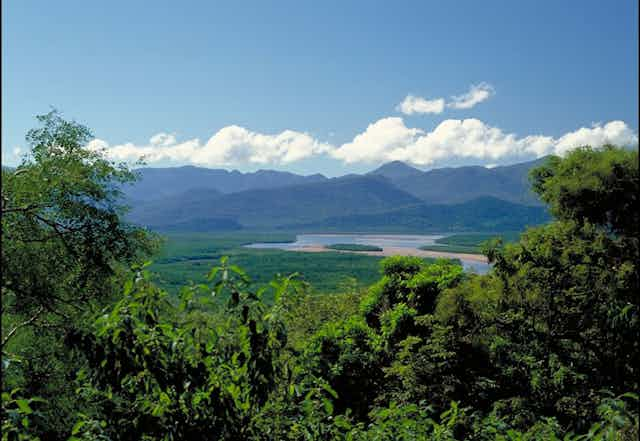Our EcoCheck series takes the pulse of some of Australia’s most important ecosystems to find out if they’re in good health or on the wane.
The largest area of tropical rainforest in Australia – the so-called Wet Tropics – is a narrow strip along the northeast coast of the continent, totalling about 2 million hectares.
It represents just 0.26% of the continent, but is crammed with hugely diverse landscapes: rainforests, sclerophyll forests, mangrove forests and shrublands, as well as areas of intensive agriculture and expanding urban rural population centres.

The Wet Tropics are home to a dizzying array of plants and animals. These include at least 663 vertebrate species, 230 butterflies, 135 different dung beetles and a remarkable 222 types of land snail. The area is teeming with more than 4,000 plant species, including 16 of the world’s 28 lineages of primitive flowering plant families.
In all, the Wet Tropics bioregion contains 185 distinct ecosystems. Of these, 18 are officially listed as endangered and 134 are of conservation concern.
Wild riches
Just under half of the region is covered by the Wet Tropics of Queensland World Heritage Area, the world’s second-most-irreplaceable natural world heritage area. A recent analysis listed it as the planet’s sixth-most-irreplaceable protected area in terms of species conservation, and its eighth-most-irreplaceable when considering only threatened species.
Yet despite its global conservation significance, the Wet Tropics was recently described by the International Union for the Conservation of Nature (IUCN) as a World Heritage Area of “significant concern”.
This is due to the threat posed to the area’s biodiversity and endemic plants and animals by invasive species, diseases and predicted climate change impacts. Only two other Australian world heritage properties are listed as “of concern”: the Great Barrier Reef and Kakadu National Park.
Given these concerns, one might expect research dollars to be flowing towards the Wet Tropics. In fact, the opposite is happening: the new National Environmental Science Program has pledged a paltry A$10,000.

While we’re talking money, it’s worth pointing out that the Wet Tropics are a goldmine. In its 2014-15 report, the Wet Tropics Management Authority calculated that this natural global asset is worth a whopping A$5.2 billion each year – roughly half of it from tourism.
A 2008 report found that the Wet Tropics create the greatest economic benefit of any of Australia’s natural world heritage properties, excluding the Great Barrier Reef. It found that every dollar spent on management costs earned an A$85 return in tourism spending. Even in purely economic terms that makes a pretty compelling case for conservation.
Climate and conservation
But there are question marks over the Wet Tropics’ future, not least because it is considered a hotspot for impacts from climate change. This is primarily due to the very large predicted declines in range size for almost all of the vertebrates that are unique to this part of the world, such as the iconic lemuroid ringtail possum. Climate change is likely to force some species to shift their geographic ranges, or face extinction.
Many of the species at greatest risk of extinction from climate change are confined to higher elevations and thus have very limited scope for dispersal. Of all the rainforest vertebrate species in the Wet Tropics, 30% live within the coolest 25% of rainforest. This gives them nowhere to go if things warm up. For unique species, that figure is even higher, with 45% living in these cooler areas.
Nor is the future too bright for many mountaintop plants, according to a study that modelled the future of suitable climate conditions for 19 species found only above 1,000 m elevation.
The study predicted that, by 2080, 84% of these species would have no suitable habitat anywhere in the Wet Tropics, and so would no longer be able to survive there.
Cat-ants-trophe

The climate isn’t the only problem. Another is the accidental introduction of one of the world’s worst invasive species, yellow crazy ants, into two locations in the Wet Tropics.
Judging by the ants’ impacts elsewhere, this is an impending natural catastrophe. Based on the small amounts of research in the region so far, ecologists Lori Lach and Conrad Hoskin predict that a large invasion of yellow crazy ants could affect most of the animal species in the Wet Tropics.
These impacts could be direct – through predation and harassment – or indirect, such as by the removal of invertebrate prey or disruption of processes such as decomposition, pollination and seed dispersal. The potential for knock-on effects in a system as complex and interconnected as the Wet Tropics rainforest is very high.
We have only a small window of opportunity – perhaps five years at most – to keep the Wet Tropics safe from yellow crazy ants. The cost of failure by the Australian and Queensland governments is unimaginable. Yellow crazy ants are also a threat to agriculture and urban areas, so we should anticipate a successful and properly funded eradication campaign — mirroring the papaya fruitfly eradication efforts in the same region back in the mid-1990s.
If the siege can be repelled, we can hopefully go on enjoying the Wet Tropics – not to mention the money it generates – for many years to come.
Are you a researcher who studies an iconic Australian ecosystem and would like to give it an EcoCheck? Get in touch.

